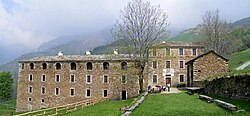Sordevolo
Sordevolo | ||
|---|---|---|
Comune | ||
| Comune di Sordevolo | ||
 Trappist monastery of Sordevolo. | ||
| ||
Location of Sordevolo | ||
 Sordevolo Location of Sordevolo in Italy Show map of Italy  Sordevolo Sordevolo (Piedmont) Show map of Piedmont | ||
| Coordinates: 45°34′N 7°59′E / 45.567°N 7.983°E / 45.567; 7.983 | ||
| Country | Italy | |
| Region | Piedmont | |
| Province | Biella (BI) | |
| Government | ||
| • Mayor | Riccardo Lunardon | |
| Area | ||
| • Total | 13.8 km2 (5.3 sq mi) | |
| Elevation | 627 m (2,057 ft) | |
| Population (31 December 2010)[1] | ||
| • Total | 1,334 | |
| • Density | 97/km2 (250/sq mi) | |
| Demonym(s) | Sordevolesi | |
| Time zone | UTC+1 (CET) | |
| • Summer (DST) | UTC+2 (CEST) | |
| Postal code | 13817 | |
| Dialing code | 015 | |
Sordevolo is a comune (municipality) in the Province of Biella in the Italian region Piedmont, located about 60 kilometres (37 mi) northeast of Turin and about 7 kilometres (4 mi) west of Biella.
Sordevolo borders the following municipalities: Biella, Graglia, Muzzano, Occhieppo Superiore, Pollone, Lillianes.
The village is located in the Elvo Valley, a natural land at the foot of the Alps, in the middle of a religious and cultural area. Sordevolo can be considered a place of faith and popular devotion, whose widest expressions are the seven churches ( and aup to the last century three brotherhoods, too), and the Passion Play, while in the past were the Last Judgement Play in the XIX century and St. Augustine drama, played in 1777. Sordevolo is also historically bound to the textile industry, that influenced the life of the village for centuries.
La Passione, a magnificent Passion Play
Every five years an impressive representation, sacred in the topic, popular in its realization, actively involves the entire community of Sordevolo (1.300 inhabitants). These are only some of the numbers which can give the idea of the magnificence of the Passion Play by the "Associazione Teatro Popolare di Sordevolo":
200 years of "Passion", since 1816;- more than 400 amateur and voluntary actors aged between 5 and 80;
300 people "behind the scenes";
40 shows in 100 days, 3 of which completely performed by children;
29 scenes constituting the 2 hours long performance;
2400 seats under cover in an Amphitheatre in front of an open air scenery 4.000 squared meters wide;
40.000 spectators.

Sight scenography
The last edition in 2015 has obtained the Patronage from the Ministry of Cultural Heritage and Activities such as from the Papal Committee for the Cultural Heritage of the Church.
The next edition will take place in 2020, from June 13 to September 27, and will be able, with its touching realism and special effects, to take the spectator 2.000 years back in time.
The script of the Play is a text in verses that dates back to the end of the XV century, written by Giuliano Dati, chaplain of the church of the Forty Saints Martyrs in Trastevere, Rome. The text was played every year in the Colosseuem during the Good Friday beginning around the 1490, by the Arciconfraternita della Beata Vergine del Gonfalone with a great success of people, travellers, pilgrims and notables. In 1539 Pope Paul III banned the play during the difficult years of the Church Reformation. Nobody knows when and how the text was brought in Sordevolo, but in 1816 the Play found new life. The most ancient text used in Sordevolo is a copy of the original roman manuscript printed in Turin in 1728, now exhibited and preserved in the Museum of the Passion, inside the Church of Santa Marta, one of the churches of the village.

Sanhedrin and Last Supper room
The entire scenography, realized by the inhabitants with their own means and competence, rebuilds in the wide amphitheatre a corner of Jerusalem in the 33 a.C.: Herod's Palace, the Sanhedrin, Pilate's Praetorium, the Garden of Gethsemane, the Last Supper room, the mount Calvary. A major effort is necessary to prepare hundreds of costumes, too. The Play also includes the use of many horses, a roman chariot and a donkey.

Pilate's Praetorium
During all a summer the people of the whole village become a theatrical company: workers and professionals, shopkeepers and clerks, retired people and students, all of them strictly volunteers and living in Sordevolo, set up a play unique in Italy, working and preparing themselves during several months before, with strong seriousness and commitment. This Passion in Sordevolo has not only a daily and immediate worth, it must be seen as a continuation of a work born several centuries ago and has to be an example for the future generations. The Committee rules impose to give the net proceeds of every edition to charitable institutions.
References
La passione di Cristo (Sordevolo)
^ All demographics and other statistics: Italian statistical institute Istat.




Comments
Post a Comment